HP Z210 SFF Workstation: Serious Power in Cramped Quarters
by Dustin Sklavos on August 29, 2011 8:10 PM EST- Posted in
- Systems
- IT Computing
- Intel
- HP
- Xeon
- Quadro
- Workstation
- SFF
- Enterprise
- NVIDIA
Application and Futuremark Performance
Unfortunately even in the business sector we're not fully able to escape from under Futuremark's shadow, but the SSD in our review unit should give the HP Z210 SFF some breathing room, and the Sandy Bridge architecture underpinning the Xeon E3-1245 will help tremendously.
In our review of the Dell Precision T1600, their representatives took issue and rightfully so at our inclusion of benchmarks from overclocked gaming desktops in our comparison. That's one area where this review will diverge; we're including only benchmarks from non-overclocked machines. It goes a long way towards narrowing down our results, but hopefully we'll get more workstations on hand in the future and build up a solid collection of data.
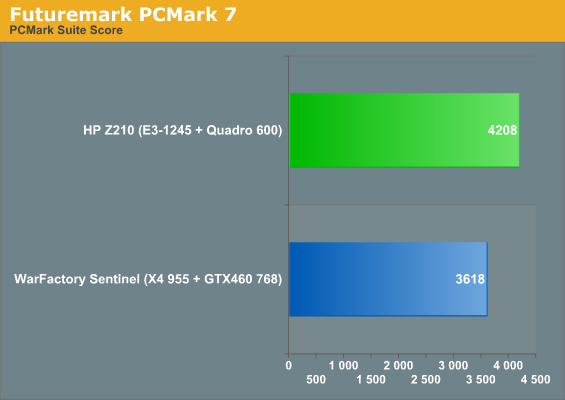
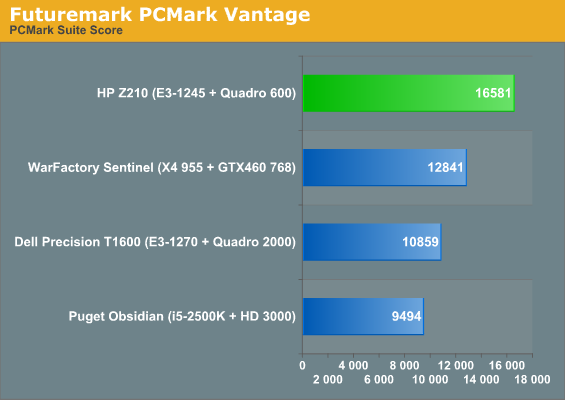
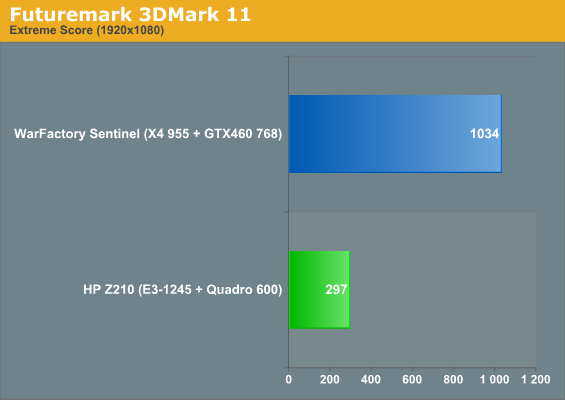
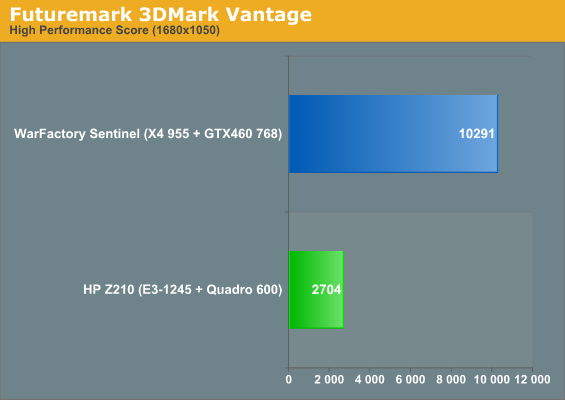
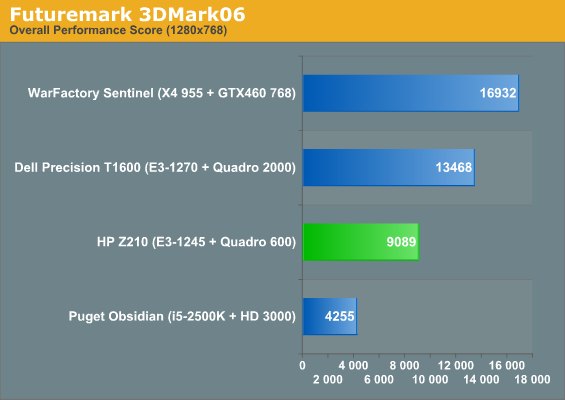
PCMark always skews heavily towards SSDs, so despite the Dell Precision T1600 having a faster processor and video card than the HP Z210, it still winds up losing in our PCMark tests. That's not really inaccurate as a representation of system usefulness, though, since the SSD will make a far more noticeable impact in overall responsiveness than a slightly higher CPU clock (unless you happen to run CPU-intensive workloads most of the time). As for the 3DMarks, we mainly use those scores to demonstrate that these aren't gaming graphics cards but do hold an appreciable performance advantage over Intel's integrated graphics.
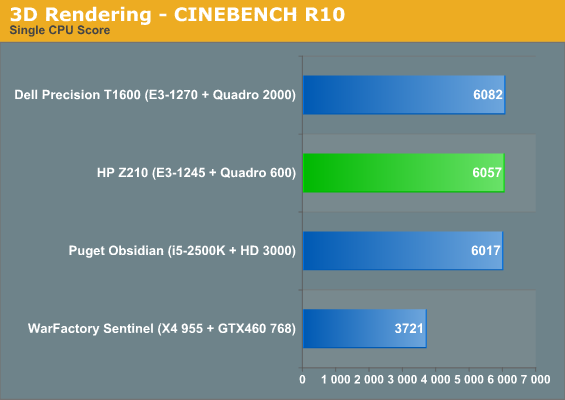
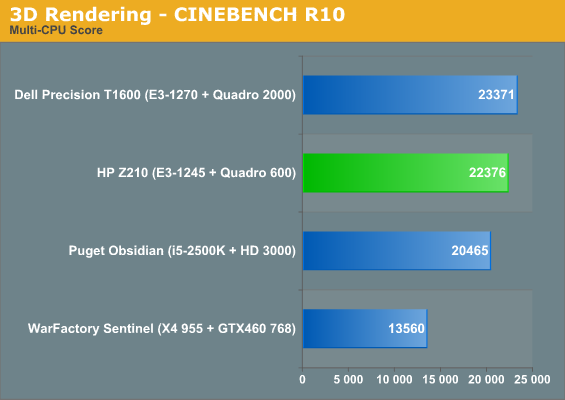
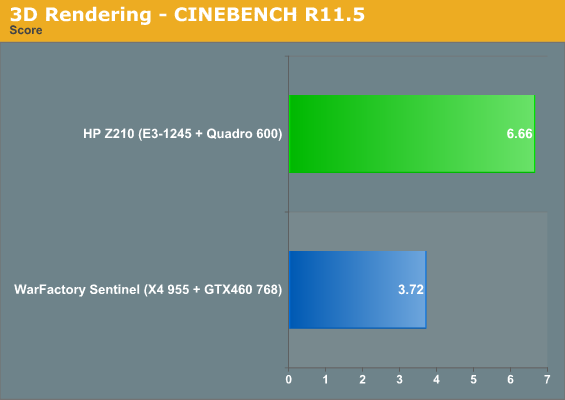
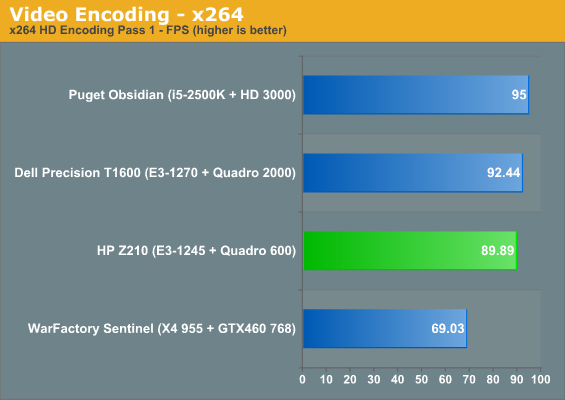
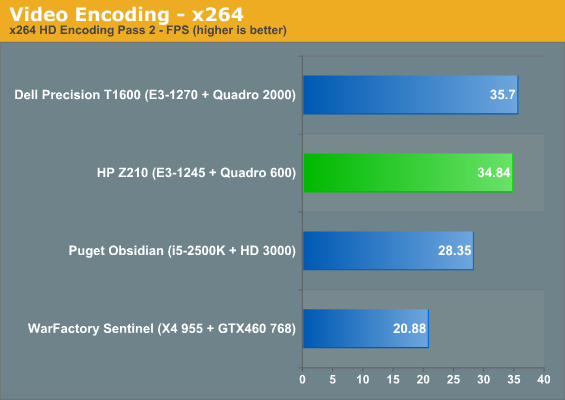
When we get to the proper application benchmarks, a couple of points immediately surface. First, the 100MHz clock speed difference between the E3-1245 and E3-1270 is wholly unremarkable. Second, the second pass on the x264 encoding benchmark sees the Core i5-2500K taking a substantial dive behind the identically-clocked Xeon E3-1245; perhaps the extra 2MB of L3 cache is paying off dividends here, or Hyper-Threading is playing a role. Third, AMD desperately needs Bulldozer. If the performance of the Phenom II X4 955 in the WarFactory Sentinel is any indication of how current Opterons are doing, AMD needs a much faster processor to get a bigger slice of that sweet, sweet enterprise market mark-up.










25 Comments
View All Comments
The Von Matrices - Tuesday, August 30, 2011 - link
I thought BTX was dead due to the rise of integrated memory controllers (difficult memory trace layout), but it's used in this case. I'm sure you couldn't get nearly as good thermal performance with an ATX layout, which is why I wish BTX had caught on in the build-your-own market.jecs - Tuesday, August 30, 2011 - link
I builded a minitower PC back in december 2010 and it happens to include a 2600K and a Nvidia Q600 + 8 MBs of memory and W764. It is a great system and it was about $1500 from Newegg, Amazon and a local CompuUSA. So it is a mixed commercial PC with an entry Quadro to run 3D apps, mostly Maya 2011, but I run 3D terrain modelers, Photoshop or gaming engines with an Nvidia 460 installed on another slot (both cards at the same time). It runs very well and stable, I haven't overclocked the CPU but is really fast. For comparison it renders one image using Maya software or Mental Ray as fast as my Mac Pro 2008 with 8 Xeon cores at 2.8 MHz. But at some other rendering jobs as toonshading the 2600K doubles the Mac Pro performance (because the memory subsystem in the newer i7). However the Mac Pro is the machine I run all day and night and it is as stable as it possibly can be, it never fails and it runs cool and silent. But for 2K the HP including a Xeon is very competitive. Also the size (not the shape) is appealing to me.I need a Mac for FCP and because I have a ton of images, references, fonts, software, devices connected I like OSX and I am proficient using the Mac. I will upgrade the MP at the end of this year. I am thinking to try the top iMac that includes the 2600K, but I am afraid the iMac wont be able to handle all the demanding job the Mac Pro does or it may not be as easy to upgrade, handle everything, exchange HDs. etc The Mac Pro is a very solid workstation based on Xeon technology.
An experience I can share is the BIG difference a Quadro makes in Pro 3D, it is not only the performance numbers you can digest. I tested the 460 alone and it is a horrible card for that. The Q600 produce an image in the viewport the 460 can't touch.
I am glad I have both machines to run what I need at critical times and now I will always have both the Mac and PC combination. It gives me literally 2 eyes to try many things and I do.
Great article and Please keep doing Xeon and workstation reviews.
Dustin Sklavos - Tuesday, August 30, 2011 - link
Do me a favor and humor me, because I do my video editing on the PC side (I know, I'm weird) on Adobe Premiere CS5.5: how has the switch from FCP7 to FCPX affected you?jecs - Tuesday, August 30, 2011 - link
It hasn't yet! because I did not "upgraded" immediately (clever me) but it was shocking to know Apple's new strategy and in general the massive complains it generated and why. Being an early adopter has been hard on me lately on both Mac (Software and hardware) and PC (hardware). I guess I will investigate in detail how the new FCPX will affect me and when I feel confident I will upgrade. As for Premier Pro I guess I will download the trial and see how it works before the upgrade to FCPX.On the humor side everything is working great now, thanks! but what a pain it is to discover you want to desperately go back and stay there (if you can).
Parhel - Tuesday, August 30, 2011 - link
Looks quite similar to SFF version of the Optiplex 990. The have an Ultra SFF as well, but it doesn't have an expansion slot for discrete video. I was considering one of those as the base for an HTPC build. Only thing that held me back was 2-channel sound. Would be interesting to see how this compares.koinkoin - Tuesday, August 30, 2011 - link
Well what you would need is a video card with HDMI audio support.I got it in an optiplex 960 and works like a dream, you can get a AMD low profile card that would fit in there I guess.
GTVic - Tuesday, August 30, 2011 - link
While one Anandtech reviewer recently referred to HP as a slow moving company, compared with Lenovo, as stated in this article, they do come up with enterprise hardware using the latest technology fairly quickly.In our organization we migrated to Windows Vista about 3 years ago and are about to move to Windows 7 next year. The hardware we received at the time was reasonable but already more than a year old in terms of when the chip hardware was released by Intel. I have a Lenovo S10 workstation that takes 90-120 seconds to boot up when you factor in all the corporate crap and is not noticeably faster than their standard desktop. They are proposing to replace this NEXT YEAR with the "BRAND NEW" S20 which can be found in reviews dating back to August 2009 (PCMag).
We should be getting this type of equipment and the EliteBook or ProBook laptops and higher end workstations as needed instead of the Lenovo one-size fits all crap we are getting now.
Death666Angel - Tuesday, August 30, 2011 - link
Hello!Thanks for the article (haven't read it all, yet), but I wanted to ask you if you can also post the measurements of the case in the metric system (mm or cm) for your international viewers. Anandtech sometimes has both, sometimes just the metric one and sometimes just the imperial one.
It would be much appreciated.
Toshio - Tuesday, August 30, 2011 - link
Thanks for the article! Tho I like to build my own gaming pc for home, at work we're considering workstations like this because of service, warranty, etc. I'm stunned by the OpenGL performance of the Quadro 600 card, didn't think there was such a gap compared to GTX580-class GFX.Only one question: this SFF system uses a proprietary PSU, right?
mike_ - Tuesday, August 30, 2011 - link
CS5 benchmarks are all well and good, but I would reckon if you're in the market for one of these then you're in either engineering (ie, CAD or similar) or development, and the benchmarks covered neither.Linux performance would have been a welcome comparison also, as 7 can be a bit tiresome running workstation loads at times. Perhaps pull some of the server benchmarks out here? With something like this it won't be uncommon to run several server applications + virtual machines + development tools on the same box.